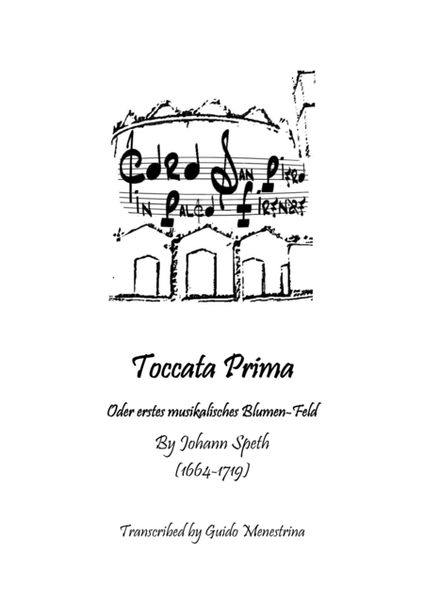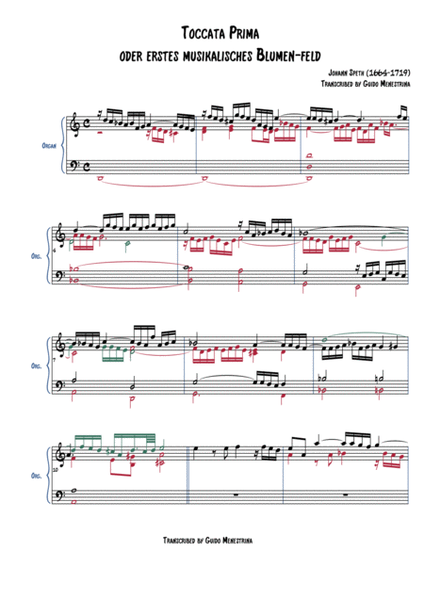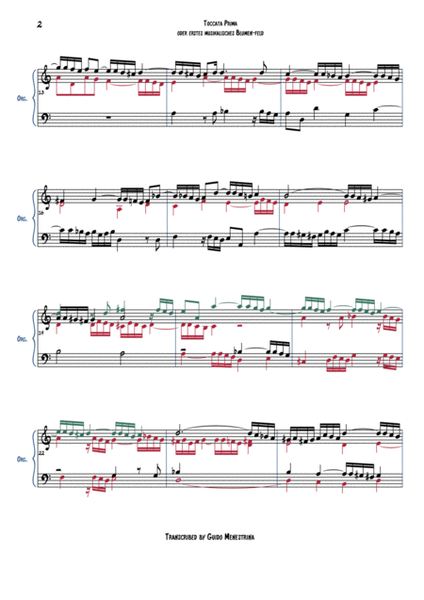Johann Speth - Toccata Prima - Transcription by Guido Menestrina
 Instant Download
Instant Download
Details
Description
SKU: A0.828694
Composed by Johann Speth. Arranged by Guido Menestrina. Baroque. Score. 6 pages. Guido Menestrina #115545. Published by Guido Menestrina (A0.828694).Johann Speth (1664-1719) - Toccata Prima oder erstes musikalishes Blumen-Feld Transcribed by Guido Menestrina - youtube https://www.youtube.com/watch?v=8huOtZ9bQak From Wikipedia: Johann (Johannes) Speth (9 November 1664 – after 1719) was a German organist and composer. He was born in Speinshart, some 150 km from Nuremberg, but spent most of his life in Augsburg, where he worked as cathedral organist for two years. His only surviving music is a 1693 collection, Ars Magna Consoni et Dissoni, which includes toccatas, Magnificat versets and variations in south German style. Speth was born in Speinshart, Bavaria, to teacher Heinrich Speth and his wife Margareta (née Vichtl). Past scholars established that Speth must have received music lessons from the abbot of the Premonstratensian monastery at Speinshart, one Dominikus Lieblein, however, this has recently been disproven. Nothing is known about his life before 1692, when he applied for the position of organist of Augsburg Cathedral. The application, which contained Speth's compositions, was accepted, and he was appointed organist on 4 November 1692. The music he supplied with the application was published the next year in Augsburg as Ars magna Consoni et Dissoni. In the files of the cathedral administration there is a note from 1705 showing that Speth had also to work in the office of the cathedral chapter. The exact date of Speth's death is unknown, but there is a document that shows that in 1719, he still lived with his wife and a maidservant in Augsburg. The composer's only surviving work is the collection published in 1693 in Augsburg, Ars magna Consoni et Dissoni. The title may be a reference to Athanasius Kircher's famous book, Musurgia universalis, sive ars magna consoni et dissoni (1650). An early description of the work was included by Johann Gottfried Walther in his Musikalisches Lexicon; Walther claimed Speth only compiled the pieces but did not compose. This hypothesis is now generally considered false. Ars Magna contains music intended for organ or clavichord: 10 toccatas (subtitled Musicalische Blumen-Felder), 8 Magnificat settings, and three variation sets. The music has clearly traceable Italian influences, with direct borrowings: one of the variation sets is built on a theme by Bernardo Pasquini, there is also a passage from Bernardo Storace in the Spangioletta variation set, and a verset by Alessandro Poglietti (quinti toni no. 3). The influence of contemporary southern organists is also apparent, particularly that of Georg Muffat and Johann Caspar Ferdinand Fischer. The toccatas are unusually short for the genre; most consist of three (toccata-fugue-toccata) sections. There are some interesting features such as dynamic indications in Toccata quarta. The Magnificat settings are, like similar pieces by Johann Kaspar Kerll and others, short versets for alternatim practice.
This product was created by a member of ArrangeMe, Hal Leonard’s global self-publishing community of independent composers, arrangers, and songwriters. ArrangeMe allows for the publication of unique arrangements of both popular titles and original compositions from a wide variety of voices and backgrounds.
Digital Downloads are downloadable sheet music files that can be viewed directly on your computer, tablet or mobile device. Once you download your digital sheet music, you can view and print it at home, school, or anywhere you want to make music, and you don’t have to be connected to the internet. Just purchase, download and play!
PLEASE NOTE: Your Digital Download will have a watermark at the bottom of each page that will include your name, purchase date and number of copies purchased. You are only authorized to print the number of copies that you have purchased. You may not digitally distribute or print more copies than purchased for use (i.e., you may not print or digitally distribute individual copies to friends or students).



 Share
Share